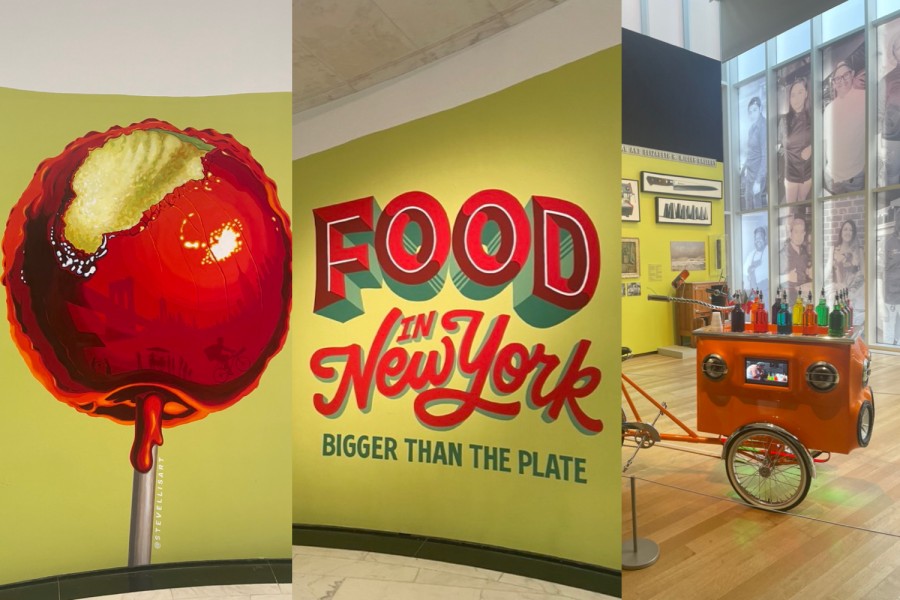The food New York City eats, and where it comes from
Fabio Parasecoli, one of the curators of “Food in New York: Bigger Than the Plate,” a special exhibition now on view at the Museum of the City of New York, gives you a guided tour.
“Food in New York — Bigger Than the Plate” features work from 20 different contemporary artists and designers. (Daeun Lee for WSN)
February 9, 2023
New York City is home to cuisines from all over the world. From the Jewish staple matzo ball soup to Cantonese siu mai, name any dish and you can likely find a restaurant that serves it — with top quality at that.
But have you ever wondered about the cultural dynamics of food in New York City? The exhibition “Food in New York: Bigger Than the Plate” runs through fall 2023 at the Museum of the City of New York, located on the Upper East Side. Featuring works by 20 contemporary artists and designers, this exhibition delves into the intricacies of New York City’s food system, touching on topics from sustainability and food security to labor justice.
Illustrated by Rick Meyerowitz and Maira Kalman, the Sub-Culinary Map is a faithful testament to the diversity of cuisine that is embedded in every part of this city. Each subway station is renamed to represent the local food available as soon as you get off of the stop. It is, by far, my favorite part of this exhibit — it nonchalantly yet confidently connects the multiethnic web of cultures of New York City.
While standing in awe at the map, I fell in love with the two stations “Bi Bim” and “Bop” which, when put together, become a staple Korean dish — Bibimbop, a bowl of mixed rice with meat and assorted vegetables. Not only does the dish bring me back home, but it accurately represents the city — its ingredients just as unique as the city’s people.
As the co-curator, Fabio Parasecoli of the NYU Department of Nutrition and Food Studies led a group of students on a tour and shared a bit more about the exhibit’s creation.
This interview has been edited for length and clarity.
WSN: What is “Food in New York: Bigger Than the Plate” all about?
Parasecoli: We wanted visitors to feel more like participants in the food system — not only as individualistic consumers, but also as part of collective involvement, because there are certain issues that cannot be resolved by personal decisions. You need to change a regulation, a policy. We wanted visitors to come out of the exhibition with a sense of agency for change and innovation. At the same time, we wanted to celebrate food in New York City. We wanted to make sure that people recognize the variety of food in New York, from food trucks to fine dining establishments. We didn’t want to focus on the negatives, we also wanted people to know about the positives.
WSN: How did you strike a good balance between showcasing positive and negative aspects of food production?
Parasecoli: We tried to show both sides of everything. On the one hand, we showed problems with food production. At the same time, we showed urban farming as a community experience — something that everyone can connect to. We have a whole window covered with photographs of people who cook for us, who nourish us. It was not just worrying about the issues, but it was also the people feeling empowered to celebrate the good that is there.
WSN: What made you bring an exhibition on the cultural dynamics of food to the Museum of the City of New York?
Parasecoli: They wanted to bring the London exhibition to New York. Since I had been a consultant and an advisor for the one in London, they asked me if I wanted to help organize the one in New York. Here, I was not just an advisor — I became a co-curator. My involvement was part of the conceptualization, even deciding where pieces would go and the text, creating a much more hands-on experience.
WSN: Why should people be more aware of their food and modes of production?
Parasecoli: Because food is one of the many aspects that makes us members of the community and members of a society. It’s partly a question of making sure that what you eat is healthy, that it’s produced correctly, that it’s sustainable and that it doesn’t exploit people. Many of us in New York care about these issues. If you scratch the surface a little, all of these aspects become visible. It transforms into a form of responsible citizenship. Citizenship is not just voting. We are all stakeholders in this because the food system impacts us from the point of view of policy, of regulation, of health, of environment.
WSN: How can students become more involved with, and improve, the larger food system?
Parasecoli: On a smaller scale, they can get involved in a local farm, so that they can connect more with their neighborhood. There are numerous food kitchens and food banks, so these are small steps. Also, you can be a little more careful when cooking, such as making decisions about what to buy and what you throw out. On a larger scale, you can become involved in farmer’s markets such as GrowNYC.
In inviting visitors to become part of the food system, this exhibition also demands our participation in the community that we live in. Food is one aspect of life that cannot be neglected.
Contact Daeun Lee at [email protected].
























































































































































